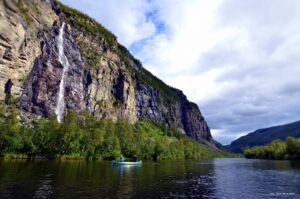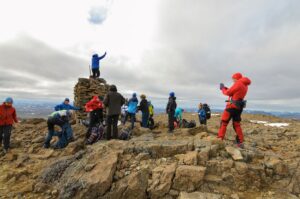Out now: Siggen Seminar 2024 Report!
From 4 – 6 of March, Marine Protected Area experts gathered at Gut Siggen in Germany to discuss how we can achieve more Effective Management of Marine Protected Areas.
Catching the wave: How can we achieve more effective management in Marine Protected Areas?
The EU Biodiversity Strategy set an ambitious target for 2030, with at least 30% of the sea area to be legally protected (with 10% of the sea area to be strictly protected) by 2030. Furthermore, it clearly identifies the urgency to ensure that all Protected Areas across Europe are effectively managed, with the realisation of conservation objectives and appropriate monitoring. As such, Marine Protected Areas (MPAs) have an important role to play and are called to make a serious effort to improve their effectiveness.
But what do MPAs need to do to reach this target, and how can progresses be monitored and assessed? What guidance, tools and methods would be helpful to improve the management of our MPAs?

Participants exchange at the 2024 Siggen Seminar
To start working on answers to these questions, exchange experience and learn from each other, 10 experts in Marine Conservation gathered at Gut Siggen in Germany. Valuable inputs were provided by expert Sue Wells, who has worked with IUCN, WWF and many other organisations on the topic of Management Effectiveness. She is currently a member of IUCN WCPA Marine Management Effectiveness Task Force.
Seminar objectives
With this seminar, we aimed to:
- Increase participant’s knowledge on why management effectiveness is at the core of EU conservation strategies;
- Share experience on main challenges that undermine effective management of MPAs;
- Acquire knowledge on some of the most common/recommended indicators to assess Management Effectiveness.
Practical approach
To ground the discussions and exercises, three case studies were used as the basis:
- Thea Hamm presented the Lower Saxon Wadden Sea National Park, Germany.
- Lasse Kurvinen presented the Bothnian Sea National Park, Finland.
- Josefine Gottschalk presented the Pomeranian Bay – Rønne Bank Nature Conservation Area.
These case studies provided real life examples of how Management Effectiveness can be implemented and were at the base of all group exercises. Group exercises focussed on the importance of indicators, monitoring and evaluation and how Management Effectiveness fits into the adaptive management cycle. Check out the report for all insights! Furthermore, all presentations and handouts can be found at the event archive page here.
EUROPARC wants to thank all participants for their active contributions. A special thanks is of course also extended to the Alfred Toepfer Stiftung for welcoming us at Gut Siggen.

Experience the Magic of the Háldi Transboundary Area during the 2024 TransParcNet Meeting!
Photo: Mollis Til Sieimma
Come join us from September 2nd to 5th, 2024, for an unforgettable TransParcNet Meeting in Háldi Transboundary Area, hosted by Finland and Norway!
What is TransParcNet Meeting?
TransParcNet Meeting is the annual meeting of network of all certified EUROPARC Transboundary Parks. This meeting plays a vital role in promoting transboundary cooperation amongst European Protected Areas. By facilitating dialogue and collaboration between neighbouring parks, the event encourages the sharing of resources, expertise, and experiences to enhance conservation efforts and sustainable development in border regions.
About the event’s location
This year’s TransParcNet Meeting will take place in the stunning Háldi Transboundary Area, where Norway’s Reisa National Park and Ráisduottarháldi Protected Landscape Area meet Finland’s Käsivarsi Wilderness Area. Covering 3000 km² of untouched nature, this place is like nowhere else, with no towns or people, just pure wilderness where animals roam free and adventures await.

Photo credits: Rune Benonisen
Programme
We will start the meeting by exploring the nuances of climate change impacts in the Fennoscandian High North through insightful discussions led by expert speakers. We will then delve into the realm of climate change adaptation tools and uncover the latest advancements in this field. Additionally, insights into EU policies supporting cross-border cooperation will be provided. Furthermore, participants will have the opportunity to address transboundary issues through their own short presentations, fostering dialogue and collaboration amongst attendees!
All Are Welcome
Whether you’re already part of EUROPARC’s Transboundary Programme or simply interested in learning more about it for potential future participation, we invite you to join us! Secure your spot now by registering here and be a part of this exciting event.

Photo credits: Rune Benonisen
Registration PageWhat to bring
In the Arctic, September can surprise us with all kinds of weather. That’s why we recommend packing smart. Bring layers, a good jacket, warm gloves, and sturdy shoes. Don’t forget your backpack for snacks and water, plus sunglasses to enjoy the sunny days. Have a look at the registration page above to get all detailed information!
Out now: European Day of Parks Social Media Pack!
Neusiedlersee National Park (AT). Photo by sebastianfreiler.com
Let’s collectively speak up for Europe’s Parks and Protected Areas this European Day of Parks (EDoP)!
Vote for Nature
With this year’s theme “Vote for Nature – Bring policy decisions to life” EUROPARC wants to highlight just how important our Parks and Protected Areas are for the implementation of (nature) policies and global agreements.
All information on this year’s EDoP
As always, we ask the wider Protected Area network to organise events on and around the 24th of May. Furthermore, this year we want to show a united voice across social media. Let’s highlight to the general public and policy-makers all that our protected natural spaces are doing for the benefit of the wider society.
To help Parks, Protected Areas and parter organisations get started, we have created a special European Day of Parks 2024 Social Media Pack. It contains key messages, images and further interesting reading to underline how Parks and Protected Areas are bringing policies to life!
Share this with your communications team and be sure to post across social media on the 24th of May. Of course, don’t forget to tag EUROPARC:
- Facebook & X: @EUROPARC;
- Instagram: @EUROPARC_Federation;
- LinkedIn: @EUROPARC Federation
and use #EDoP2024, #VoteForNature and/or #EuropeanDayOfParks.
We look forward to seeing your events, activities and posts!

The European Day of Parks is made possible through funding of the LIFE Programme. Views and opinions do not necessarily reflect that of the European Commission or of CINEA.
Management effectiveness evaluation shows: Finnish park management is of high standard but challenges lie ahead
Photo description: Evaluation Team visiting fortress island Vallisaari. Long closed for military use, the site has remained one of the most diverse nature destinations in the archipelago of capital city Helsinki. From the left: Ben Ross, Nigel Dudley, Sue Stolton (team leader), Michael Hošek, Kari Lahti, Petri Ahlroth, Yu-Fai Leung. Team members absent: Ari-Pekka Auvinen and Naira Dehmel.
Photo: Mervi Heinonen, Metsähallitus Parks & Wildlife Finland
Expert article from Matti Tapaninen, Senior Specialist, Tourism. Metsähallitus Parks & Wildlife Finland.
Conservation agencies around the world need plenty of timely, transparent and quality information to be able to manage their national parks and nature reserves efficiently. In addition to the baseline information of ecological, cultural, social and economic values of Protected Areas, there is growing interest to monitor trends and predict changes in the future. Needs to measure and enhance management effectiveness are also recognized in the Kunming-Montreal Global Biodiversity Framework, which states:
Ensure and enable that by 2030 at least 30 per cent of terrestrial and inland water areas, and of marine and coastal areas, especially areas of particular importance for biodiversity and ecosystem functions and services, are effectively conserved and managed.
EU and national biodiversity strategies play a crucial role in achieving this goal.
Protected Area Management Effectiveness
Protected area management effectiveness (PAME) assessment is a useful tool to organize great amounts of information and it helps to get fresh insights from external evaluators. In 2004, Finland was the first country in the world to commission an independent review of the management effectiveness of the whole protected area system. In 2023, Metsähallitus Parks & Wildlife Finland (PWF) repeated the process. The Evaluation Team itself consisted of experts representing a range of expertise, including managing a park agency, biodiversity research units, conservation-related private consultancies, and visitor and tourism management.
The 2023 PAME Assessment
The 2023 PAME assessment was guided by the Principles of Protected Area Management in Finland, which encompass key components of management objectives, ecosystem services and ecosystem approach, and adaptive management process that are operating under a changing environment along with national and regional obligations. The evaluation protocol entailed a system-wide questionnaire with six broad categories of questions, including context, planning, input/resources, process, outputs, and outcomes.
Special attention was paid to important changes in the management context since 2004, as well as future domestic and regional trends that may facilitate, hinder or otherwise impact management effectiveness in one or more categories. The focus of evaluation was on the protected area system in Finland, but additional evidence was obtained from site assessments using the Management Effectiveness Tracking Tool (METT) in five Protected Areas.
According to the PAME assessment report management of Protected Areas in Finland is of a high standard and the protected area system managed by Parks & Wildlife Finland works well. However, significant challenges lie ahead. Many species are endangered, threats due to climate change are increasing and resources available for management are declining. Henrik Jansson, Executive Director of Parks & Wildlife Finland, says:
The international assessment is an important step towards safeguarding biodiversity and more effective conservation work. This assessment provides guidelines for increasing the impact of the work and helps to compare our competence internationally. Next, we will analyse the recommendations and draw up a development plan from them. We will prioritise the recommendations that we can implement promptly.
A comment by Michael Hošek, President of EUROPARC Federation and member of the international evaluation team
Globally, Finland was the first country to develop a methodology to evaluate the effectiveness of its Protected Areas system in 2004. Moreover, Finnish colleagues understood the importance of an independent perspective, i.e. they invited international experts to the evaluation team.
In 2023, after 20 years, the evaluation was carried out again. The methodology was updated, of course, but with the awareness that the results could be compared to see trends in development.
Personally, I consider the combination of the assessment at the level of the Protected Areas network and the specific sites of great importance. We cannot assume that we have the capacity to carry out a very thorough and repeated evaluation of effectiveness at the level of each individual site. The Finnish example is innovative in this respect, as it combines the assessment at the level of the network and a sample of sites while maintaining the quality of the result. And to make the evaluation truly independent, it is really important to invite colleagues from other countries to the team, taking into account the experience of other countries within Europe and the world. And I hope we have done that. I am personally very happy with the result.
More information
Full evaluation reportThe full evaluation report Management Effectiveness Evaluation of Finland’s Protected Areas 2023 (pdf)
Report summary and recommendationsThe report summary and its recommendations (pdf): Management Effectiveness Evaluation of Finland’s Protected Areas 2023 – Summary of the Evaluation Report and Recommendations.
System level evaluationSystem-level evaluation of protected area management effectiveness for Parks & Wildlife Finland (PAME) – complete assessment questionnaire with evaluation criteria (pdf)
Evaluating Effectiveness (IUCN)Evaluating Effectiveness: A framework for assessing management effectiveness of protected areas. 2nd Edition. (IUCN publication, pdf)